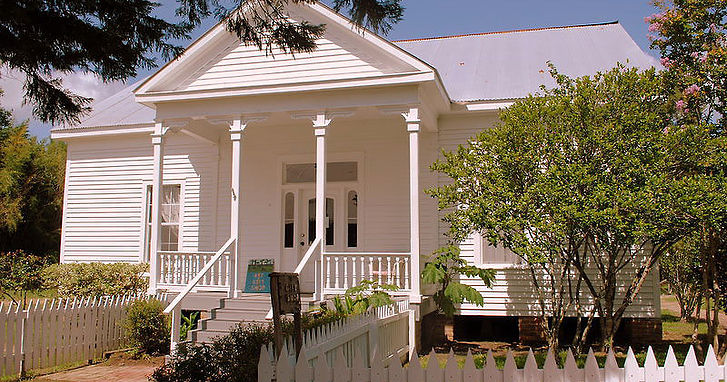
Doctor Salles’ House
This home was once the private residence of Dr. Hypolite Salles, the first resident dentist in Lafayette. He also owned the “Doctor’s Museum,” which is located next door in Acadian Village. It is set up today just the same as the good doctor practiced in the late 1890s.
The Acadian Village administrative offices are now located in Dr. Salles’ home and is closed to public tours.
Bernard House
Constructed in St. Martinville, Louisiana, the Bernard House is the oldest structure in the Village. The section on the left was built first (circa 1800) while the section on the right is an addition (circa 1840).
Upon entry into the addition, one will see a large painting of the exile of the Acadians from Nova Scotia (Canada) in 1755. The painting in the small rear room depicts their arrival and settling along the bayous of Louisiana in 1764–1765. These paintings were created by Louisiana artist Robert Dafford and were commissioned by one of the Acadian Village founders, Bob Lowe.
The oldest section of the home contains an exhibit on Cajun music and in this home is the best example of the type of insulation used within the homes. It is called bousillage entre poteaux (mud between posts).
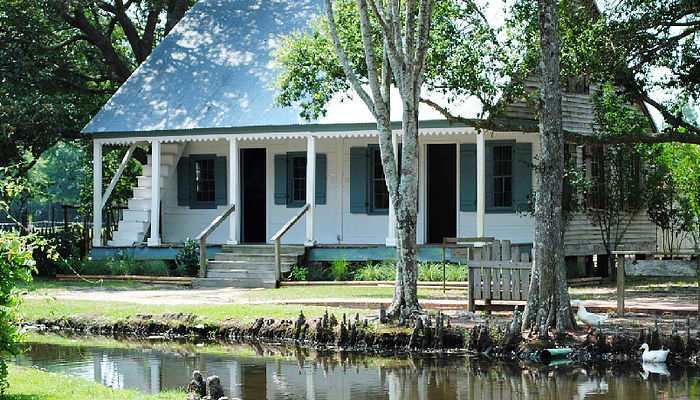

Billeaud House
The Billeaud House comes from the Billeaud Sugar Plantation in Broussard, Louisiana. It was built after the Civil War. Today it is used as our spinning and weaving cottage.
One of the looms is original, being 150 years old. The other is a replica, built locally by 72-year old Mr. Whitney Breaux.
Homespun blankets and clothes were woven from white cotton, native to Louisiana, and brown cotton which was introduced from Mexico to the Acadians.
Blacksmith Shop
This is a replica of a blacksmith shop, built on site with weather-beaten, aged cypress boards. The blacksmith was a very important person in a community because he was the one who made tools, horseshoes, nails, hinges, and other iron products.
The anvil, forge, and bellows are much like those used long ago. The tongs, pincers, hammers, and other items on the wall are part of the smitty’s collection. Also scattered about are tools that have been the mainstay of farmers throughout the years here in Southwest Louisiana.
Acadian Village’s resident blacksmith is Charles Goulas. Charles can be found in his shop during special events such as concerts, cook-offs, and Noel Acadian au Village, the village’s spectacular Christmas Lighting Program. During these events, Charles will demonstrate century-old techniques of blacksmithing and often sells his crafts.
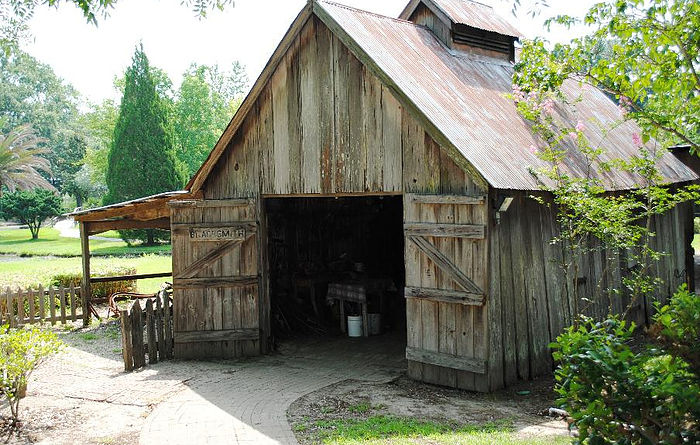
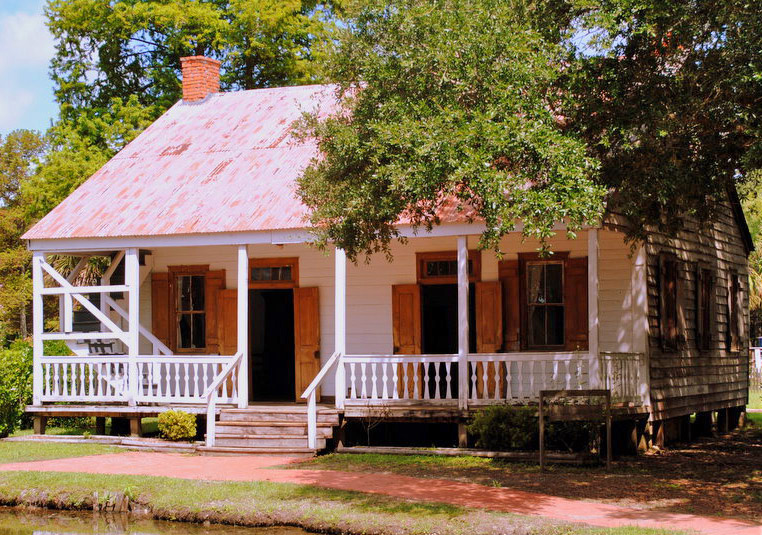
Castille House
This historic landmark at the Village was built for Dorsene Castille (circa 1860) in Breaux Bridge, Louisiana, by a European of whom little is known of except that it took him over a year to complete.
During the Civil War the house was pillaged by Yankee soldiers, but somehow has survived the ravages of time.
The cypress mantels in the home are of interest. Each has a carved emblem on the front. The outside figure looks like a Christian fish and symbolizes a long and happy life. The center emblem looks like a rosette and is called progression. It signifies a large and prosperous family.
Doctor’s Museum
The Doctor’s Museum was at one time the office of the first resident dentist in Lafayette, Dr. Hypolite Salles. Built in 1890 of cypress, the architecture reflects Greek revival influence. The original cypress shingles are still on the structure beneath the corrugated tin roof. The tin roof was added as protection following a devastating fire at the Lacoste Hardware Store which stood on Jefferson Street between 1910 and 1920.
A collection of period furnishings, medical and dental instruments, bottled medicines, and powders popular at the time are displayed throughout the three-room structure. There are also medical books and diplomas of area physicians of the late 19th and early 20th century
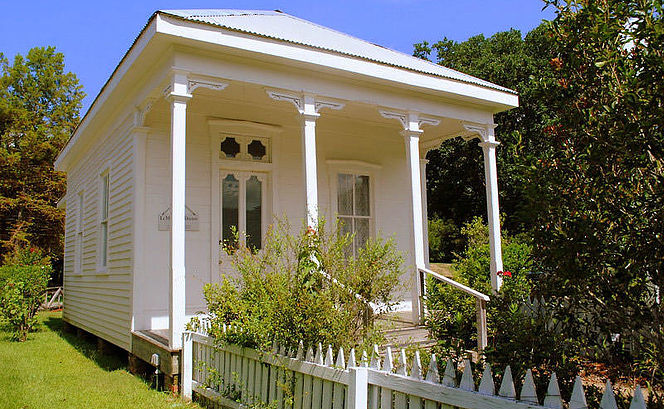
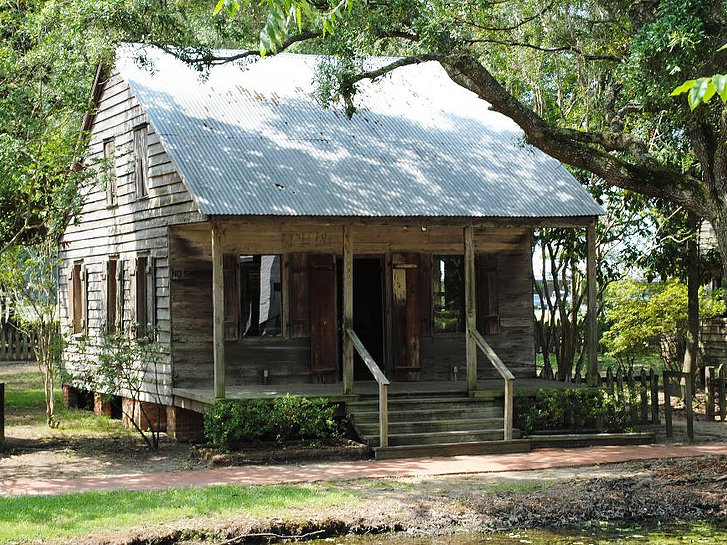
LeBlanc House
Built between 1821 and 1856 near Youngsville, Louisiana, the LeBlanc house is the birthplace of Acadian Senator Dudley J. LeBlanc.
Cajun politician and entrepreneur Dudley J. “Couzan Dud” LeBlanc was born on August 16, 1894. He attended Southwestern Louisiana Institute, and during World War I served as a sergeant in the U.S. Army. In 1924, LeBlanc was elected a member of the Louisiana House of Representatives, and in 1926 became Public Service Commissioner. He served as State Senator from 1940 to 1944, 1948 to 1952, and in 1964. In 1945 he established the Happy Day Company, which manufactured the popular Hadacol brand health tonic. Hadacol had 12 percent alcohol, and it guaranteed to cure all ills. LeBlanc promoted Hadacol extensively, sometimes using major entertainers as spokespersons.
An active Cajun culture preservationist, LeBlanc served as president of the Association of Louisiana Acadians, and in the late 1960s helped to establish CODOFIL (Council for the Development of French in Louisiana). He authored three books: The True Story of the Acadians (1927); The Improved Version (1932); and The Acadian Miracle (1966, a revised and expanded version of his first book). LeBlanc appealed to political supporters via radio in Cajun French, at a time when Cajun French was rarely heard on radio. He died on October 22, 1971, and was buried in Abbeville.
The LeBlanc exhibit contains memorabilia from the life and times of “Couzan Dud.”
New Hope Chapel
The New Hope Chapel is a replica of an 1850 Acadian chapel. The architects were Don Breaux and Robert Barras. It was built through the efforts of the Knights of Columbus.
The ceiling is built of cypress and is held up by pegs. The floor is made of Louisiana long leaf pine that is about 200 years old.There is only one original pew and it is 150 years old. The rest are copies made by Mr. Whitney Breaux. The Stations of the Cross were hand carved with a chisel, knife, and hammer by a local sculptor, Mr. Lester Duhon.The main alter is the type used before Vatican Council II.
It originally served St. Anne’s church in Youngsville, Louisiana and later St. Joseph’s in Milton, Louisiana.
It was donated to the Village by Mrs. Jules Hebert of Milton. The side altar (Last Supper scene) is a gift from an anonymous donor who left it on the porch of the general store.

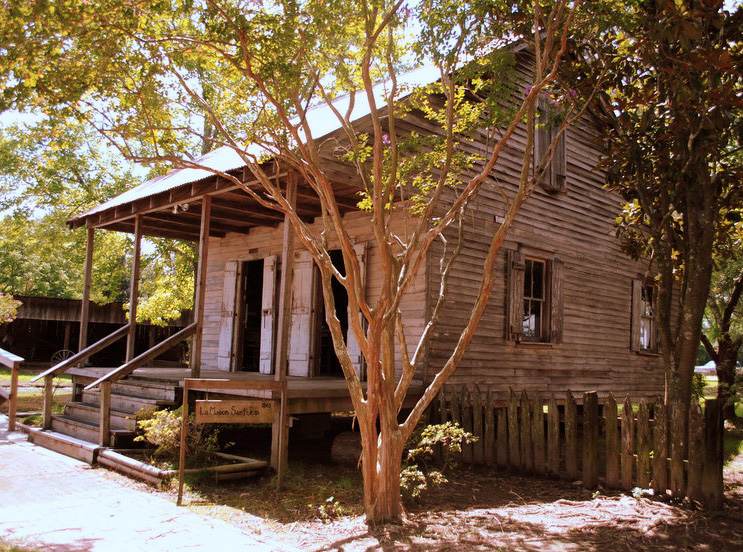
Saint John House
This house dates to 1840 and was donated to the Village by a local dentist. It was located on St. John Street near downtown Lafayette, hence its name. It is built of salvaged cypress timbers from another building.
The house is currently being displayed as a schoolhouse. Among the desks is a three-seater which came to the Village from an old schoolhouse in Sunset, Louisiana. Old books, inkwells, lunch pails, and a wooden stove round out the exhibit.
Thibodeaux House
The Thibodeaux House is constructed of cypress, the “wood eternal,” that is rot and insect resistant. Each pre-cut beam and post is marked with Roman numerals for ease in assembling. The house dates to 1820 and came to the Village from the Breaux Bridge, Louisiana.
The small, rear “cabinet” room, the daughter’s room, is accessible only through the parent’s room. The boys slept in the attic/loft or “garconnier,” reached by way of an outside staircase.


T-Paul’s House
Paul Duhon was a fixture at Acadian Village for 30 years. He was born on September 18, 1917, to a family that can trace their heritage back to the 1600s in France. He also has a branch of the family tree that came to Louisiana with the original Acadien settlers from Nova Scotia in the 18th century. T-Paul, as he was known, didn’t have any children of his own, but he loved to entertain the school children who would visit the village. He played the spoons for them and delighted them with his tunes on his Cajun washboard (which learned to play by ear).
T-Paul was 90 years old when he passed away in 2007. With T-Pauls’ savings, his brother, Willie Duhon, built a house in his memory. The T-Paul house is built with old cypress from Lafayette and Abbeville and houses a sample of his knife collection and some of his wood carvings.
Acadian Homes and Furniture
The homes and practically all furnishings were made locally because of the difficulty of transporting materials. Their furniture consisted of benches, chairs, tables, and chests. Straight backed chairs and rockers with cane, cow-hide, or deer-hide seats were used extensively.
In the bedroom one usually found a four-poster bed with a teaster, a canopy over the bed. Under the large bed, there was usually a trundle bed or “roulette”, which was built low on casters. At night it was pulled out for the small children to sleep, and in the summertime it was put on the porch or “galerie.” There were holes in each of the four posts so that short poles could be inserted to hold the mosquito bars, which had to be suspended over the sleeping child. In the morning the trundle bed was made up and pushed out of sight.
There was a wash stand or “lavabo” in each bedroom. Usually these were made of wood, but those who could afford it used marble tops because water did not stain it. On the wash stand there was a bowl and pitcher, while near it was hung a hand towel of home-made cloth.
“Armoires” were used because a closet could be considered a room and the family would be taxed for it. The more elaborate armoires had a full length mirror on one of the doors. This piece of furniture had two compartments. Folded linens and clothes were stored on shelves on one side, and dresses were hung on the other side.
The Acadians were deeply religious, each home had a shrine of some type. It it was a glass-enclosed case containing a statue or religious figures placed on the mantle over the fireplace.
In the kitchen, as elsewhere in the house, the furniture was home-made. The tables were often made of cypress and the chairs were upholstered with hide. Here, near the open fireplace where cooking was done, were all types of black iron pots. In the corner was a “garde-manger” or old fashioned pie safe with cheesecloth screened doors. These were used by the early settlers to keep insects away from food. In the kitchen there was also coffee grinders and large pottery crocks.
The larger homes had dining rooms. Again home-made tables and chairs were prevalent. Over the table there may have been a punkah fan, which was a swinging fan attached to a rope that went through the wall. A small boy on the outside pulled the rope to drive away flies and fan those who were eating. The dining room often had a china closet called a “vaisselier”, in which better dishes were kept.
